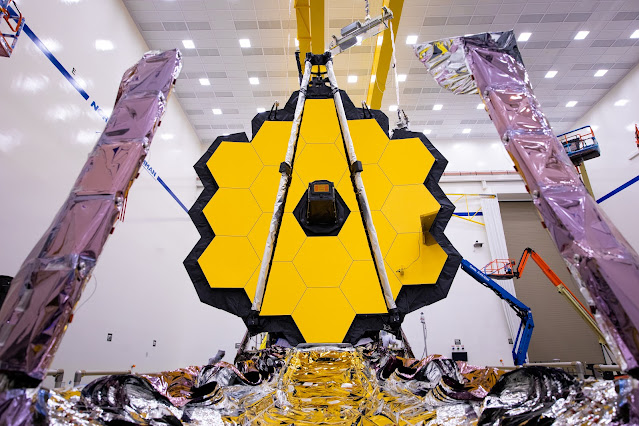NASA's James Webb telescope launches into space after 35 years
Starting this Saturday we will be a little closer to knowing the deepest secrets of the Universe thanks to the James Webb Space Telescope , the largest and most powerful observatory ever sent into space by humans.

|
| James Webb Space Telescope |
We are talking about a mission that leaves their mark: as heir to the Hubble space telescope, it is called to become the next great space science observatory , as it is designed to answer pending questions about the Universe and to make revolutionary discoveries in all areas of astronomy.
Behind such a task are the National Aeronautics and Space Administration (NASA), the European Space Agency (ESA) and the Canadian Space Agency (CSA), three heavyweights when it comes to studying the Universe .
This Saturday, December 25, as if it were a Christmas present, an Ariane 5 rocket has left the European spaceport of French Guiana to deliver 6,200 kg of mass into space, including the Webb observatory, the consumables in orbit and launch vehicle adapter.
Webb will embark on a month-long journey to its final orbit approximately 1.5 million kilometers from Earth , in an orbit around the second Lagrange point of the Sun-Earth system, L2.
In the first three weeks after launch, Webb will unfold his parasol, which is the size of a tennis court , and then unfold his 6.5-meter primary mirror made up of 18 unique parts that will detect faint light from distant stars and galaxies. with a sensitivity one hundred times greater than that of Hubble.
Your mission
As we say, this telescope is the next great space science observatory after Hubble, designed to answer outstanding questions about the Universe and make important discoveries in all fields of astronomy.
As we say, this telescope is the next great space science observatory after Hubble, designed to answer outstanding questions about the Universe and make important discoveries in all fields of astronomy.
In other words, what will be the replacement for Hubble will be such a powerful tool that it will even be able to investigate deep space and the origin of life that occurred with the Big Bang. Almost nothing.
Likewise, the telescope will also shed light on dark matter and the life cycle of stars.
Additionally, Webb will study in detail the atmospheres of a wide diversity of exoplanets. It will look for atmospheres similar to that of the Earth and the presence of key substances such as methane, water, oxygen, carbon dioxide and complex organic molecules, "with the exciting hope of finding the basic components of life", emphasize its promoters.
Closer to home, Webb will also study the outer planets of our own Solar System : “Many exoplanets resemble Neptune and Uranus, so studying planets in our own solar neighborhood can provide new insights to better understand planetary formation in general. ”, They add.
On-board technology
Webb has four instruments : a near-infrared spectrograph, a mid-infrared instrument, a near-infrared camera, and a near-infrared imager.
A giant five-layer shield will protect the telescope and instruments from the Sun's light and heat , keeping them permanently in the shade, where they will cool down to -233ºC. It measures 22x12 meters, about the size of a tennis court.
Its instruments are: NIRSpec, a near infrared spectrograph; MIRI, the mid-infrared instrument; NIRCam, the near infrared camera; and NIRISS, the Near Infrared Imager and Slitless Spectrograph.
Differences from Hubble
Although it is set to become the successor to the mythical Hubble, there are important differences between the Webb and that. Starting with the CSA's participation in this project and continuing with a fairly relevant factor: while its predecessor is repairable and accessible by NASA's space shuttle, the next International Space Telescope will not be repairable .
Among other things, this happens because Webb will be, as we said, a million and a half kilometers from Earth, while Hubble orbits our planet at an altitude of approximately 570 kilometers .
In addition, Hubble makes the observations at ultraviolet and optical wavelengths (with some infrared capability), while Webb makes them in the near and mid-infrared, allowing astronomers to observe distant objects; and the first has a primary mirror 2.4 meters in diameter, while the second is 6.5 meters in diameter.
Comments
Post a Comment